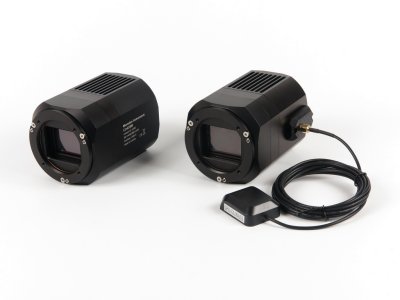
Original version of the C1×
camera and a new version with attached GPS receiver module with
external antenna C1× and C1× “T” cameras
Because majority of C1× usage
scenarios (astronomical photography, variable star research, etc.)
do not utilize the benefits of the sub-microsecond exposure timing
or external exposure triggering, and both the GPS module interface
and hardware trigger port increase the price of the C1× camera, the original variants of the
C1× cameras without these ports are
still available. The new variants with trigger port and the
ability to attach an optional GPS receiver are marked with letter
“T”.
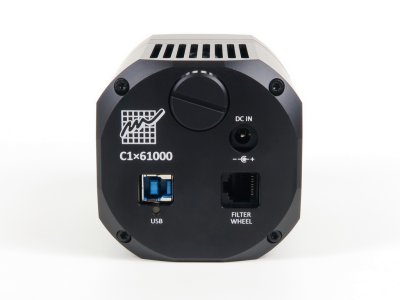
Back side of the original version of the C1× camera with the USB, Power and EWF
connectors 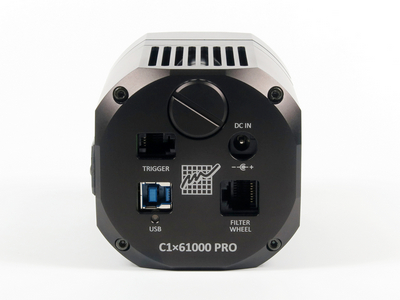
Back side of the new “T” version of the
C1× camera with the USB, Power,
EWF and Trigger connectors. GPS port cover is visible on the
left side GPS receiver module
New version of the C1× cameras
can be equipped with an optional GPS receiver module, which allows
very precise timing of the exposure times. Geographic location
data are also available to the control software through specific
commands.
There are three variants of available
modules:
GPS module with integrated antenna, compatible
with GPS and GLONASS satellites. GPS module with external antenna, compatible
with GPS and GLONASS satellites. GPS module with external antenna, compatible
with GPS, GLONASS, Galileo and BeiDou satellites.
GPS modules can be attached to the port on the side of the
C1× camera head. If the camera is
not equipped with the GPS module, the GPS port is covered with a
flat black cap.
GPS receiver module with integrated antenna
The module cover is made from orange plastic to indicate
the presence of RF antenna, which needs unobstructed view of
the sky to successfully acquire signal from GPS
satellites.
If the camera is located in the observatory dome,
especially if the dome is covered by copper or other metallic
sheets, GPS receiver may not be able to capture signal from
GPS satellites. Also, if the camera is located on the
telescope back side, so the camera back side points mostly to
the ground, GPS signal reception can be compromised.
The GPS receiver with integrated antenna also can be unable
to capture signal from enough satellites when the USB3
connection is used. Please note this issue is not specific to
the C1× camera, but it affects
any GPS receiver or other RF devices, operating in a close
proximity to a USB3 line. Using of USB2 cable solves this
problem, but at the expense of slower image download. If the
USB3 connection is used, usage of the GPS module with external
antenna may be necessary.
GPS receiver modules with external antenna
The variant of GPS module with external antenna is attached
to the camera head the same way like the version with internal
antenna. The module cover is black as it does not need any
special positioning. The cover is thinner, but there is a
connector for the GPS antenna on it. Note the module can work
only if the antenna is connected.
GPS antenna is shipped with this variant of the GPS module.
Antenna cable is 3 m long and the
antenna is equipped with a magnet, allowing it to be attached
to any ferromagnetic surface.
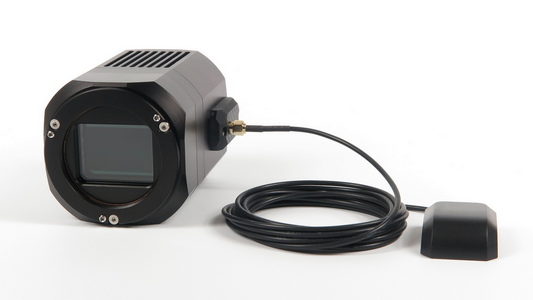
The C1× camera with
the attached GPS receiver module with external
antenna GPS receiver module handling
Please note if the GPS module is to be added later, the
camera must be sent to manufacturer. Just connecting the GPS
module to available port is not enough, it is also necessary
to reconfigure the camera firmware.
GPS module is handled through camera command set. Its main
purpose is to provide very precise timing of the exposure
times with better than μs precision (the GPS module
provides time pulses with 30 ns
tolerance). Geographic location data are also available to the
control software through specific commands.
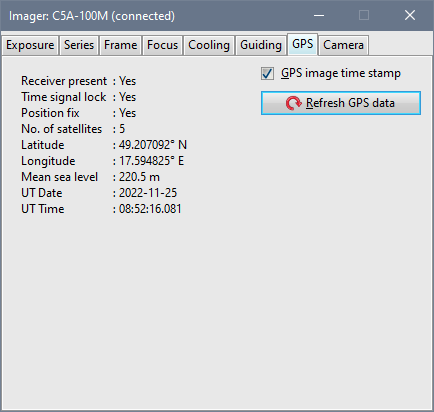
The GPS tab in the SIPS camera control tool window
shows information about GPS receiver state The GPS module needs to locate at last 5 satellites to
provide exposure timing information. Geographic data are
available if only 3 satellites are visible, but especially the
mean sea level precision suffers if less than 4 satellites are
used.
|